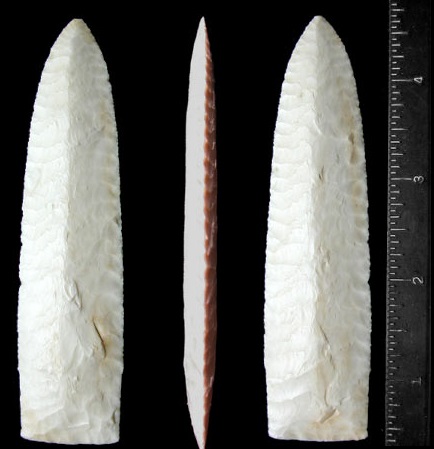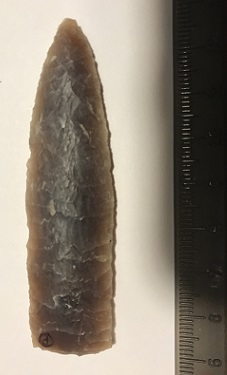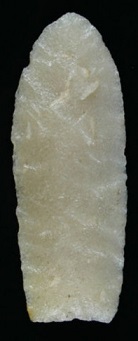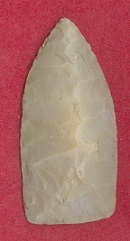Outline is Representative of Size and Shape:

Name Details:
Identified By: Joe Ben Wheat and George Agogino
Named For:
Date Identified: 1972
Type Site: Olsen-Chubbuck Bison Kill Site, Cheyenne County, Colorado
Identified By: Joe Ben Wheat and George Agogino
Named For:
Date Identified: 1972
Type Site: Olsen-Chubbuck Bison Kill Site, Cheyenne County, Colorado
Point Validity:
Valid type
Wheat was an anthropologist and professor at the University of Colorado. He served as curator for the Anthropology Museum at the University of Colorado and was an expert on the Great Plains Paleo Indians. Agogino was an anthropologist and was the founder and professor of the Department of Anthropology at the University of New Mexico. He was an expert on the Great Plains Paleo Indians. This type was named in a professional publication and has many professional references. This is considered a valid type.
Wheat was an anthropologist and professor at the University of Colorado. He served as curator for the Anthropology Museum at the University of Colorado and was an expert on the Great Plains Paleo Indians. Agogino was an anthropologist and was the founder and professor of the Department of Anthropology at the University of New Mexico. He was an expert on the Great Plains Paleo Indians. This type was named in a professional publication and has many professional references. This is considered a valid type.
Firstview Stemmed
Cluster: Plano Stemmed Cluster Description of Physical Characteristics and Flaking Pattern:
This is a medium to large lanceolate point with an elliptical cross section. Some examples have a median ridge. The blade is excurvate, curving out at the tip and with parallel edges. The shoulders are weak to absent with a straight stem. The stem, when present, is formed by heavy grinding of the hafting region which forms a slight stemmed appearance. The base primarily straight with a slight indention and has a wedge shape. The flaking pattern may vary from collateral to parallel and oblique flaking.
Size Measurements:
Total Length - 35 to 110 mm (average 55 to 75 mm), Stem Length - 12 to 21 mm (average 15 mm), Blade Width - 20 to 30 mm, Stem Width - 0 to 3 mm narrower than blade.
Total Length - 35 to 110 mm (average 55 to 75 mm), Stem Length - 12 to 21 mm (average 15 mm), Blade Width - 20 to 30 mm, Stem Width - 0 to 3 mm narrower than blade.
Commonly Utilized Material:
Additional Comments:
This point has been incorrectly identified as a Scottsbluff variant. This thought is based on an example found by George Agogino in 1964 who found an example he labeled a Scottsbluff variant, but he was unaware of the Firstview type at that time. However, the example he found was constant with the characteristics of the Firstview type. The radiocarbon dating of this point originally came back at 10,200 years old which is older than the Cody Complex points. This date has now came into question and it is thought that there was a possible contamination of dirt from the Bison hoof. Other radiocarbon dating has placed this point consistent with the date of the Cody Complex. To further complicate the dating, there was a level found at Blackwater that had a concentration of Milnesand and Plainview points that were also in association with Firstview points which may have been older than the Cody Complex (George Agogino and Matthew H. Hillsman, 1988 (see link below for the entire discussion).
This point has been incorrectly identified as a Scottsbluff variant. This thought is based on an example found by George Agogino in 1964 who found an example he labeled a Scottsbluff variant, but he was unaware of the Firstview type at that time. However, the example he found was constant with the characteristics of the Firstview type. The radiocarbon dating of this point originally came back at 10,200 years old which is older than the Cody Complex points. This date has now came into question and it is thought that there was a possible contamination of dirt from the Bison hoof. Other radiocarbon dating has placed this point consistent with the date of the Cody Complex. To further complicate the dating, there was a level found at Blackwater that had a concentration of Milnesand and Plainview points that were also in association with Firstview points which may have been older than the Cody Complex (George Agogino and Matthew H. Hillsman, 1988 (see link below for the entire discussion).
Distribution: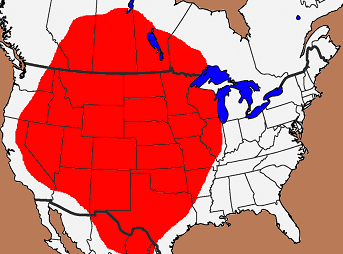

Distribution Comments:
This point is most commonly associated with the Plains States from Texas into Canada. This point may be found from the Great Basin in the west into central Mississippi River valley.
This point is most commonly associated with the Plains States from Texas into Canada. This point may be found from the Great Basin in the west into central Mississippi River valley.
Age / Periods:
Date: 9,500 - 8,000 B.P.
Cultural Period: Transitional Paleo
Glacial Period: Early Holocene
Culture:
Date: 9,500 - 8,000 B.P.
Cultural Period: Transitional Paleo
Glacial Period: Early Holocene
Culture:
Age Details:
Similar Points:
Agate Basin, Angostura, Alberta, Eden, Holland, Nebo Hill, Milnesand, Plainview, Red River, Scottsbluff
Agate Basin, Angostura, Alberta, Eden, Holland, Nebo Hill, Milnesand, Plainview, Red River, Scottsbluff
Other points in this cluster / Related / Associated Points:
Alberta, Cody Knife, Eden, Holland, Scottsbluff
Alberta, Cody Knife, Eden, Holland, Scottsbluff

